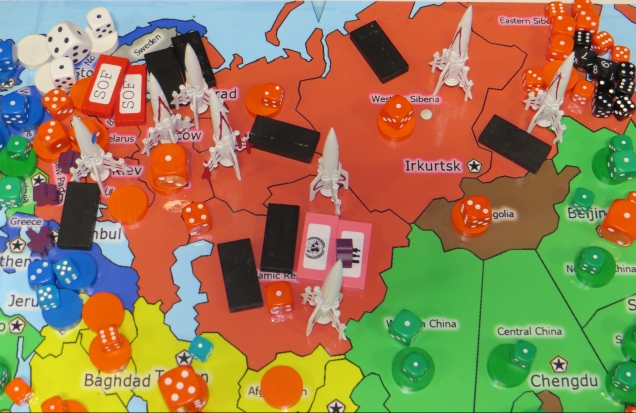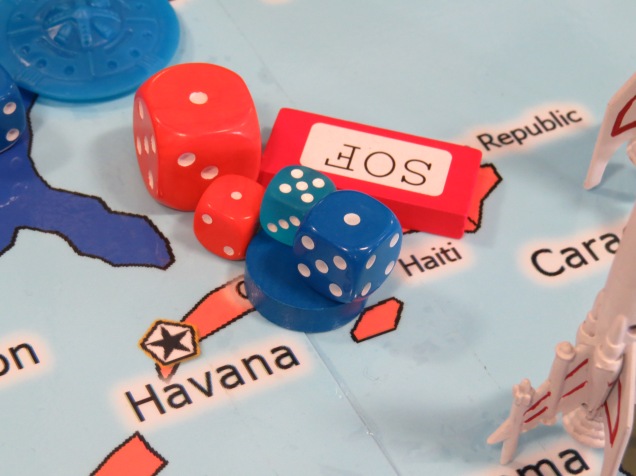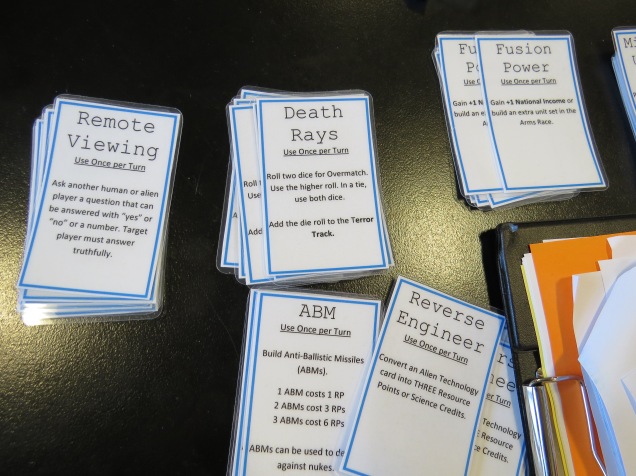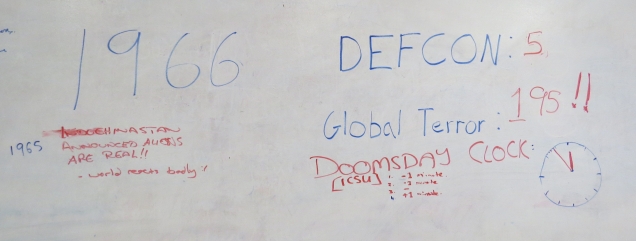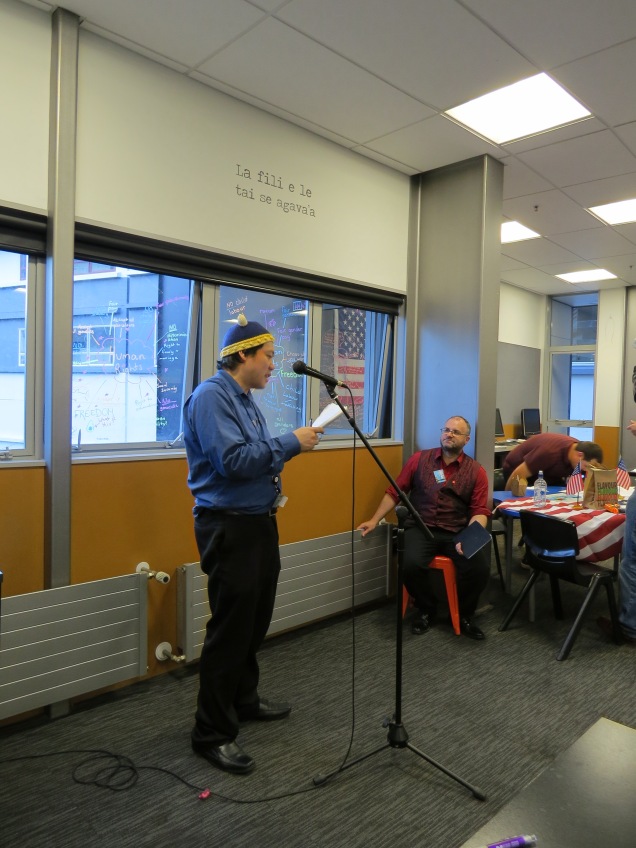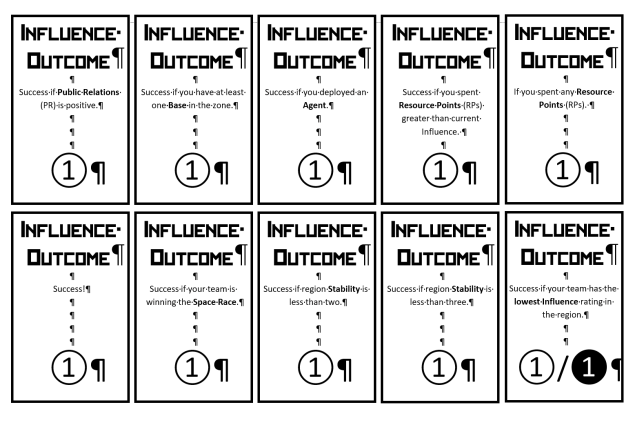In this post I will outline concepts for four different Megagames that I might be spending some time on turning into fully developed games over the next 18 months or so. Feedback is most welcome.
 Watch the Skies: Dragons
Watch the Skies: Dragons
This would be a fantasy hack of Watch the Skies, replacing Alien UFO attacks with Dragon attacks. The political scenario for the teams worried about Dragon attacks would be complicated by the adding a Dark Lady who is in the middle of an attempt to conquer and enslave the free world.
I expect the main game roles would convert as follows:
- The Scientist becomes a Sorcerer, and takes blood and bone from various slain monsters, plus lore rescued from dungeons, and uses that to research spells (because any sufficiently advanced technology resembles magic).
- The United Nations becomes the Grand Council, where the Elves, Dwarves, Free Men, etc all debate how to resist the Dark Lady, what should be done about the Dragon menace, and whether or not inconvenient bits of jewelry should be disposed of in far off volcanoes.
- Team leaders remain team leaders, but with more feudal titles and a fear of peasant uprisings. As with WTS, if there are a lot of players, then the espionage function can be taken over by another player.
- Military leaders have a dual role that could be split between two players. One role focus is on military operations with armies against the Dark Lady. The other role is focused on individual Hero characters challenging Dragons to fights, exploring dungeons for relics and lore, etc. To keep game play fast, two maps might be needed (and its established in fantasy that large armies find it impossible to find small bands of individuals bearing inconvenient jewelry).
- A merchant role focused on trade and the economy could be added, but is not essential.
The teams and other game elements would all be based on easy to recognise fantasy tropes, rather than any specific intellectual property. Possible teams include:
- The Elves
- The Dwarves
- The Crusaders
- The Fanatic Caliphates
- The Wandering Northmen
- The Vestigial Empire
- The Horse People.
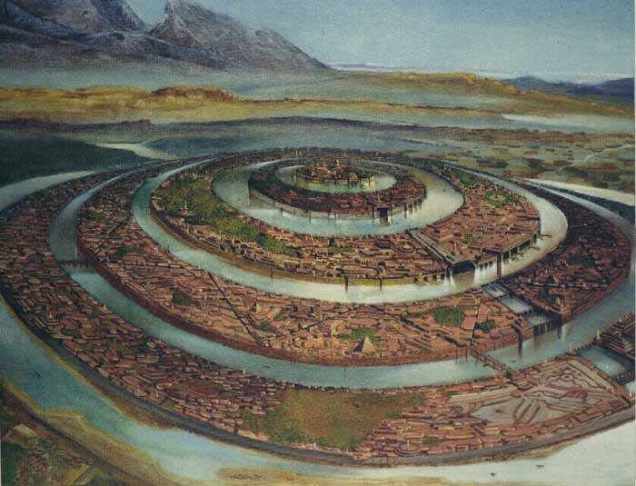 Colossus of Atlantis III
Colossus of Atlantis III
My take on ancient Atlantis features giant robots, monsters, rival empires, and ever increasing DOOM threatening to sink Atlantis. Its been run a few times now, and with that experience (plus additional research on ancient Greece and modern boardgames about the Peloponnesian War) there are some significant changes I want to make.
- Better maps: I want to move away from abstract maps and make some useful game maps of the city of Atlantis, and the colonial regions of Libya, Asia, and Europa.
- More streamlined play: the current version of the game has too many resources (Talents, Cogs, Doom, Vril, Orichalcum, Cities, Armies, Fleets, Colossi) that do too many things and can be simplified. I think combat and monster hunting can also be refined into a card draw system that hides mechanics “under the hood”.
- Less is more: an overall reduction in the game components, and placing more emphasis on player driven creative injects into the game (e.g. players describe the Great Wonder they are building, Control then assigns cost and determines game effect from construction).
- Using the city map of Atlantis to allow for civil strife to be played out. Rather than moving units around city blocks (like the JUNTA boardgame) I think a drafting mechanism with cards and a large dose of uncertainty is the way to handle coup attempts. It also allows us to have the titular Colossus of Atlantis as a combat unit in the game.
- Changing how the factions and Councils work. The approach I want to try is for everyone to have ties to more than one faction, forcing some hard choices about ultimate allegiances in the endgame. Rather than having all players resolve map actions, then team time, then council actions, and then assembly votes (which takes a long time), the game structure will involve more parallel processing, e.g. you can choose to do one of managing your colony, leading an Atlantean army against a threat, monster hunting, or voting in council politics.
- One way of doing this may be to have each map elect a Council representative (or two). While being on Council gets you access to the levers of power in Altantis, it means your colonies are not being managed effectively.
- The big assemblies where changes are made to the “constitution” of Atlantis would only happen a few times in the game, rather than every turn.
- Big projects would be more of a case of the players describing what they want, and Control adjudicating.
- Adding a significant trading game – Atlantis needs grain from the colonies, otherwise there will be riots! Atlantis has “cash”, while the colonies have “resources”.
- Factions that the game could have include:
- Amazons (for the female players, supporting female emancipation and equal citizenship rights).
- Medes (a team that supports foreign intervention in Atlantis)
- Aristocrats (a team that supports the status quo of a weak High King of Atlantis, limited citizenship rights, and no votes for women)
- Monarchists (a team that supports a strong High King of Atlantis)
- Tyrants (a team supporting a strong military dominated or Spartan style government)
- Oligarchs (a team that supports reforming Atlantis to favour political participation of the wealthy)
- Democrats (a team that supports popular rule by male citizens)
- Telchines (a team supporting radical change through sorcery and technology)
- Cultists (a team dedicated to drowning Atlantis).
 The Reaching Moon
The Reaching Moon
This would be a high fantasy scenario set in the Glorantha world originally designed by Greg Stafford, as represented in one the enduring roleplaying games from the 1970s, Runequest. I believe that a not-for-profit game would be okay under Chaosium’s fan permissions, but I would have to contact Chaosium for explicit authority before spending a lot of time on designing the game.
The big pro for using Glorantha is the incredibly rich detail of the setting.
The big con against using Glorantha is the incredibly rich detail of the setting.
I am still working my way through the PDF of the new Runequest rules that dropped last week, but I think a basic premise for the game would be setting it in the Kingdom of Tarsh, a client state of the Lunar Empire, which is the scene of a civil war with multiple factions. This would take place in the new advanced timeline, where the Dragonrise event and the liberation of Pavis and Prax from Lunar occupation has weakened the formerly dominant Lunar Empire.
The trick here will be in squaring the circle of a conflict with armies, in which individual heroes can be more powerful (with magic from otherworld mythic quests) than entire army regiments. Both need to be important, along with some logistic considerations and the intense diplomacy between all of the religious cults and political factions.
 Mars 1938 (or The Queen of Mars)
Mars 1938 (or The Queen of Mars)
The idea is inspired by the planetary romance genre, typified by the John carter “Barsoom” pulp novels, and in particular the roleplaying games Space 1889 and Rocket Age, which took the tropes of that genre and added steampunk and 1930s politics respectively. Old Mars is usually portrayed with a breathable atmosphere, but with a dying landscape littered in ancient ruins. This is the Mars of our imaginations, before the scientific probes of the 1960s revealed just how hostile and lifeless the planet is.
The key elements of this genre are Earth as a centre of technology and colonialism, with Mars as the exotic locale filled with hostile tribes and decadent monarchies (standing in for Africa and Asia). The pulp novels largely focus on individual male heroes and the exotic women that they meet and fall in love with. Swords are used a lot instead of modern weapons. For a megagame though, the enduring subject is going to be the encounter of alien civilisations, the difficulties in communicating, and the disasters that follow from misunderstandings.
One of the historical touchstones for the scenario would be the events associated with the Spanish Civil War, with its clash of ideologies (fascists, communists, socialists, anarchists, monarchists, Catholics, and regional independence movements) and foreign intervention (the international brigades, the Condor legion, League of Nation sanctions, etc). The other historical reference would be the relationship between China and other nations during its transition from Empire to Republic and collapse into Warlordism in the 1920s. This saw several wars (both with China and between the colonial powers), corruption influenced by the opium trade, secret societies, unequal treaties, palace politics, heroic sieges, rebellions, coups … all good stuff for megagames.
A note: if its the 1930s then there are Nazis, and in 1938 Adolf Hitler was Time magazine’s man of the year and not a contender for worst monster in history. I would be very explicit in the player briefing that no Nazi uniforms or insignia are to be worn in the game.
My first concept for turning this into a megagame is to focus on one large Martian empire, its internal factions, and the Terrestrial Powers. There can be a Indiana Jones minigame of rescue archaeology and ancient relics. The main game is then divided into three parts:
- The first stage of the game is the competition phase with three major components:
- The terrestrial powers are trying to gain ideological adherents among the Martian factions, and other goals such as more land, permission for missionaries, open trade agreements, arms sales, etc.
- The Martian Queen is attempting to introduce a constitution that can create a modern state system that can preserve Martian independence and the monarchy.
- The Martian factions are trying to influence the constitutions towards their own interests (like a game of Credo where Church factions argue at the Council of Nicaea), gain support from the pesky humans without alienating supporters, and gain control of recruits and weapons.
- The second stage of the game is the coup phase. This is when factions unhappy with the outcome of the first stage can stage uprisings and coups. This phase will be short and brutal.
- This is when we test for assassination – players that have betrayed their principles being more likely to be torn apart in mob violence. Player briefings would be upfront about the risk of character elimination (“Its like A Game of Thrones, on Old Mars”).
- The faction that does the best in stage one will control the Martian capital and likely be in the best position for the next stage of the game.
- At this point in time we break for lunch, assign new characters to anyone who has been assassinated, and set up the map for the next stage.
- The third stage of the game is the conflict phase. This is when we fight out the civil war, and see if any of the factions can achieve a military victory, or if a negotiated settlement occurs. The political actions from stage one will continue, allowing players to do special actions like opening the city gates in the middle of a siege, trigger peasant uprisings, or escape into a luxurious exile.
This was the most popular idea in the player poll at Wellycon, and its definitely the one that most captured my imagination this week.
